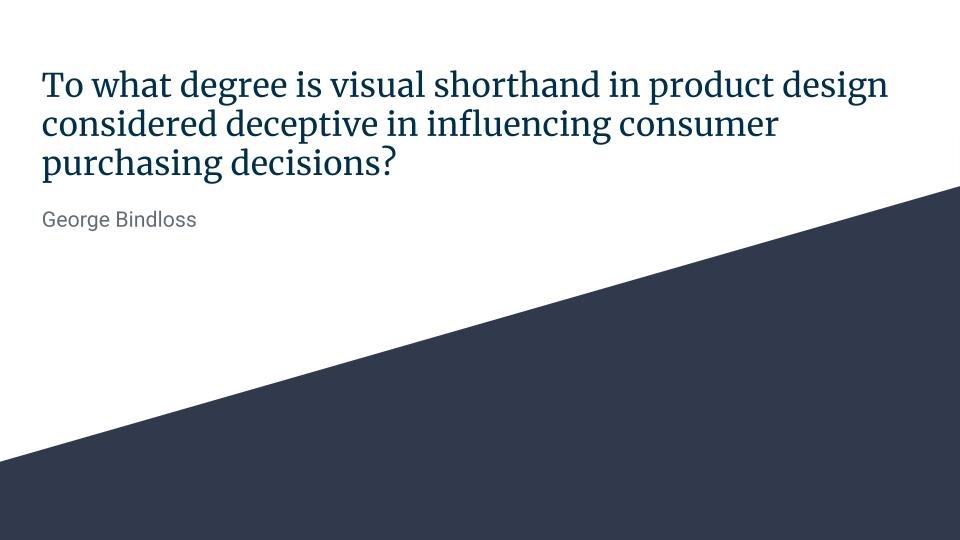Context in Design Engineering
For this project, we chose any topic to do with design engineering. I chose Visual shorthand because I was really interested in how it is used to influence buying decisions and even manipulate buyers. This is my essay on the topic and my slides for the presentation.
To what degree is visual shorthand in product design considered deceptive in influencing consumer purchasing decisions?
Visual shorthand is the use of easily interpreted graphics, colour and visual features to quickly convey a feature or contents of a product. The visual design of a product has a large impact on a consumer’s purchasing decision. In a supermarket, for example, the customer has no time to look, in detail, at each of the 30 products they buy during a weekly shop. I believe that it is only justified to alter the visual design of a product to influence a consumer's buying decisions when it is used to inform or aid the user to choose the product. Many brands use this to attempt to trick the consumer into buying a product that they don’t really need.
Visual shorthand is an understandable and simple way of displaying the function of a product, with minimal effort. On packaging icons showing recyclability, fair trade and safety symbols give a clear visual indicator to inform the consumer about the product. My favourite use of colour for functionality is Festool, any part of the product that has a function is a green plastic, this enables easy identification of functionality. Understanding a product’s function using clear visual indicators helps inform a consumer’s decision. In Aquafresh toothpaste, 3 colours are used to suggest that the 3 functions of the toothpaste come from each part, although they are all the same toothpaste. This is not necessarily misleading because the 3 claims are true even if the visual shorthand is unrelated.
Visual shorthand can also be used for bad intentions, when trying to market a product to a particular lifestyle, this is often done in subtle ways. Use of plants, nature and green in packaging can make a product look natural which implies an environmentally conscious or healthy product, these assumptions don’t need to be proved or backed up by the company. In 2013, Which? published an article on Boots and other pharmaceutical companies saying that they were, “using clever language to imply unproven benefits” [1] this intentionally “confuses buyers” into buying a supplement they, probably, didn’t need. Ironically, this article was amended the day after being released to replace a misleading photograph.
In my opinion, the worst use of visual shorthand for everyday products is the colourful designs of vapes. Bright colours are proven to attract and cause positive emotion in children [2]. Vape companies use this in combination with sweet flavourings to attract a group of people who are easily influenced to get them hooked early and make sales in the long run. This also has caused the perception of vapes to be not as unhealthy as cigarettes and as they actually are [3]. Overall, visual shorthand can be used in a helpful way to easily display the contents or function of a product but, due to its difficulty to regulate, it can also be used to mislead consumers to varying degrees.
In summary, while visual shorthand can effectively communicate a product's function or contents, its misuse remains a challenge to regulate. When employed ethically, it aids consumers in decision-making, but unethical practices can mislead consumers to varying degrees, impacting their choices and perceptions.
Use of ChatGPT - 46 words
ChatGPT guided my focus on consumer manipulation through design. It greatly aided research by generating topic ideas, though I did source hunting myself. While its rewording removed quotes and references, the conclusion it offered shaped my final piece effectively. I also reworded this analysis using ChatGPT
Links: https://chat.openai.com/share/e292c441-c932-4ae8-8796-fc3b9f85935a
https://chat.openai.com/share/e1d3c03e-2075-42cd-808b-23a40d0976a0
References - vancouver style
[1] - Which? attacks “exaggerated” food supplement health claims [Internet]. the Guardian. 2013. Available from: https://www.theguardian.com/science/2013/aug/22/which-health-supplements-misleading
[2] - Boyatzis CJ, Varghese R. Children's emotional associations with colors. The Journal of genetic psychology. 1994 Mar 1;155(1):77-85.
[3] - Smith MJ, MacKintosh AM, Ford A, Hilton S. Youth’s engagement and perceptions of disposable e-cigarettes: a UK focus group study. BMJ open. 2023 Mar 1;13(3):e068466.




